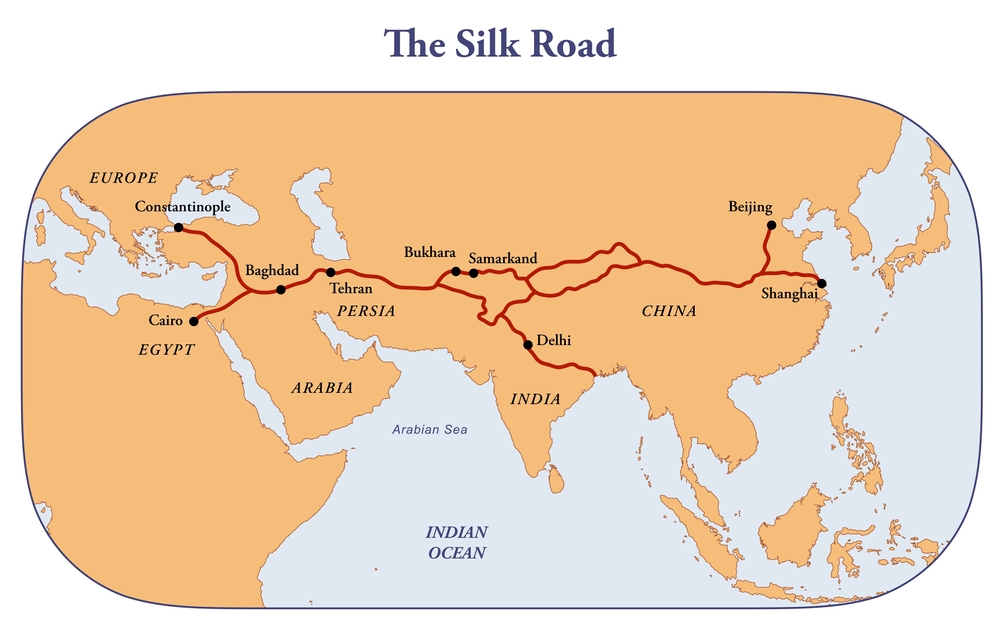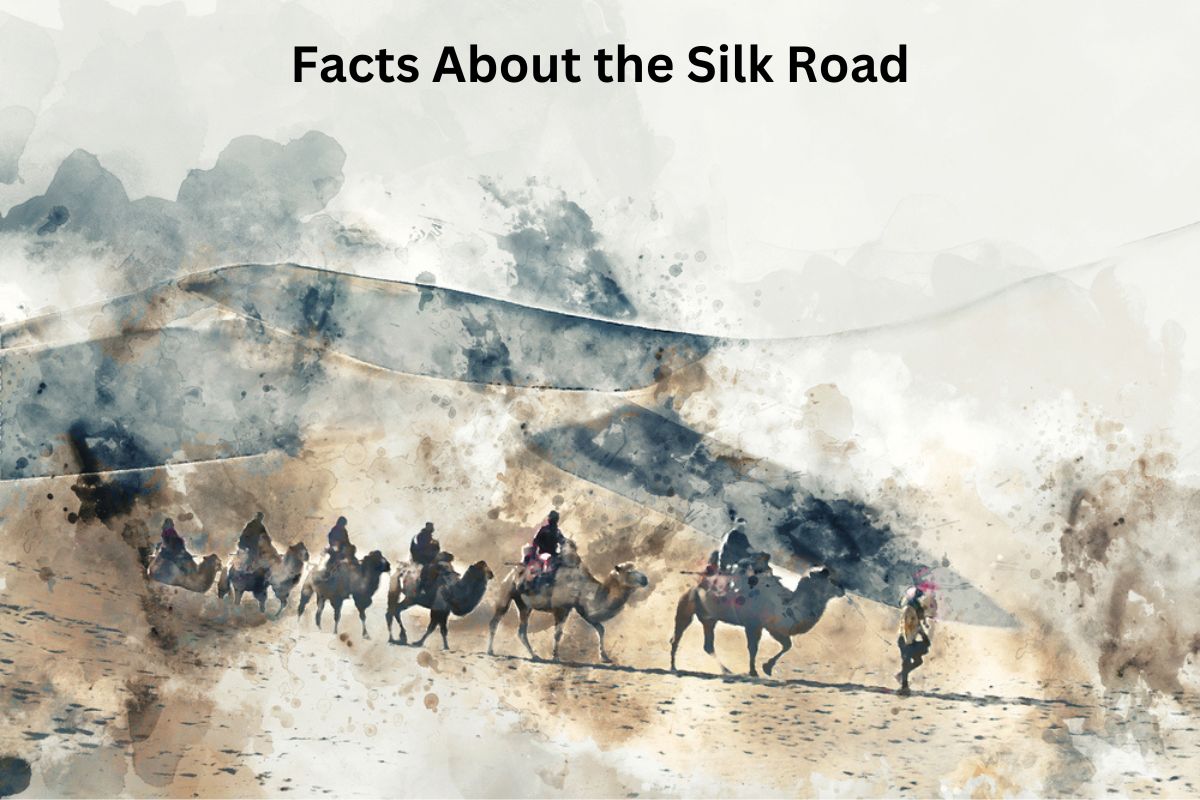The Silk Road, an ancient network of trade routes, connected the East and West from the 2nd century BCE during China’s Han Dynasty.
While silk trade played a notable role, it was more than just textiles. This vast trading network facilitated the exchange of goods, knowledge, and cultures.
Religions like Buddhism, Islam, Christianity, and Zoroastrianism spread, and ideas flowed freely. It consisted of diverse routes through different terrains, with Marco Polo’s travels popularizing it in Europe.
In the 14th century, it began to decline due to factors like Mongol invasions and maritime routes’ rise. Yet, 19th-century European explorers reignited interest by uncovering ancient cities and artifacts. Today, UNESCO recognizes several Silk Road sections as World Heritage Sites.
Silk Road Facts
1. Ancient trade network connecting East and West
The Silk Road was an extensive and intricate network of trade routes that crisscrossed Eurasia, connecting the major civilizations of the time.
It was not a single road but rather a collection of interconnected overland and maritime routes. These routes stretched from China in the East to the Mediterranean in the West, encompassing a vast geographical area.
2. Named after the lucrative silk trade
The term “Silk Road” was coined by the 19th-century German geographer Ferdinand von Richthofen. It is named after the lucrative silk trade that was a prominent feature of this network.
China was the primary source of silk production during this era, and the silk from China was highly coveted in the West for its exquisite quality and texture.
However, it’s important to note that the Silk Road facilitated the exchange of a wide range of goods, including spices, precious metals, textiles, ceramics, and much more.

3. Originated during the Han Dynasty in China
The origins of the Silk Road can be traced back to the Han Dynasty of China, which ruled from 206 BCE to 220 CE. During this time, Chinese Emperor Wu Di actively promoted diplomatic and trade relations with neighboring regions, including Central Asia and the Middle East.
This led to the opening of land and sea routes that would eventually form the foundation of the Silk Road.
The Chinese were keen to expand trade and diplomacy, and they were particularly interested in acquiring horses from the Western regions, which played a crucial role in their military strategy.
As a result, these early diplomatic missions and trade exchanges laid the groundwork for what would become the Silk Road.
4. Facilitated the exchange of goods and cultures
The Silk Road was not merely a conduit for the exchange of goods; it was also a melting pot of cultures and ideas.
As merchants, traders, and travelers journeyed along these routes, they brought with them not only commodities but also their beliefs, traditions, and knowledge.
This led to a rich tapestry of cultural exchange, where East met West and different civilizations learned from one another.
- Religious Exchange: The Silk Road played a pivotal role in the spread of religions. Buddhism, originating in India, traveled along these routes to China and beyond, while Islam found its way to Central Asia and China. Nestorian Christianity also made inroads into Central Asia and China during this time.
- Intellectual Exchange: Philosophical ideas, scientific knowledge, and artistic expressions were shared among cultures. Greek, Indian, and Chinese mathematicians and scientists exchanged ideas on topics like astronomy and mathematics.
- Artistic and Architectural Exchange: The Silk Road fostered the exchange of artistic styles and architectural techniques. For example, Greco-Buddhist art emerged in regions where Greek and Buddhist cultures met, resulting in unique artistic representations.
5. Spread religions, philosophies, and knowledge
The Silk Road played a significant role in the dissemination of religious and philosophical beliefs. As mentioned earlier, Buddhism and Islam were among the religions that spread along these trade routes.
Buddhist monks and Islamic scholars traveled to different regions, spreading their teachings and building religious centers.
- Buddhism: Buddhist monks, such as Xuanzang, embarked on arduous journeys along the Silk Road to collect sacred texts and spread Buddhist teachings. This exchange of religious ideas greatly influenced the cultures of East and Central Asia.
- Islam: The Silk Road facilitated the spread of Islam to Central Asia and parts of China. Mosques and Islamic centers were established in various cities along the trade routes.
6. Included multiple routes through various terrains
The Silk Road comprised a network of routes that traversed various terrains, each presenting its own set of challenges and opportunities for traders and travelers.
- Northern Route: This route passed through the vast Eurasian steppes, where nomadic tribes roamed. It required dealing with harsh climates and the logistical challenges of long distances. However, it offered access to valuable commodities like furs, horses, and amber.
- Central Route: The central route crossed the arid deserts of Central Asia, such as the Taklamakan Desert. Travelers had to contend with extreme temperatures and limited water sources. Key trading hubs like Samarkand and Bukhara thrived along this route.
- Southern Route: The southern route, also known as the “Maritime Silk Road,” involved both overland and maritime routes. It passed through the Indian subcontinent and Southeast Asia, connecting with maritime routes in the Indian Ocean. This route was known for its trade in spices, precious stones, and luxury goods.
Each of these routes had its own unique set of risks and rewards, and traders and travelers adapted to the challenges of their chosen path.
This diversity of routes contributed to the richness of the Silk Road’s cultural and economic exchange.
7. Marco Polo’s travels popularized it in Europe
The Silk Road gained significant attention in the West, in large part due to the writings of the Venetian explorer Marco Polo.
In the 13th century, Polo embarked on an epic journey along the Silk Road, reaching as far as China. His detailed accounts of his travels, compiled in the book “The Travels of Marco Polo,” introduced Europeans to the wonders and riches of the East.
Polo’s work became immensely popular and inspired future generations of explorers and traders, further stimulating interest in the Silk Road.
8. Declined due to factors like Mongol invasions
The Silk Road began to decline in the 14th century for several reasons:
- Mongol Invasions: The Mongol Empire, which controlled vast portions of the Silk Road, experienced internal strife and fragmentation. This led to disruptions in trade and security, affecting the flow of goods and ideas.
- Maritime Trade Routes: With the Age of Exploration and the opening of sea routes, such as those discovered by Christopher Columbus and Vasco da Gama, maritime trade became more efficient and economically viable. This shift diverted trade away from overland routes, including the Silk Road.
- Political Instability: Political instability in various regions along the Silk Road, including Central Asia and the Middle East, further hampered trade.
9. Rediscovered by European explorers in the 19th century
In the 19th century, European explorers and archaeologists rekindled interest in the Silk Road. Figures like Sir Aurel Stein and Sven Hedin embarked on expeditions to Central Asia and China, unearthing ancient cities, manuscripts, and artifacts.
Their discoveries shed light on the historical significance of the Silk Road and the cultural interactions that occurred along its routes.
10. UNESCO World Heritage Sites along its path
Today, several sections of the Silk Road have been designated as UNESCO World Heritage Sites.
These include historic cities, caravanserais (roadside inns), and other cultural landmarks that played a pivotal role in facilitating trade and cultural exchange. In recent decades, there has been a renewed interest in reviving certain aspects of the Silk Road.
China’s ambitious “Belt and Road Initiative” seeks to strengthen economic and cultural ties along the ancient routes, promoting trade, infrastructure development, and cooperation across Asia, Europe, and Africa. This initiative aims to revitalize the historical spirit of connectivity and cooperation that the Silk Road represented.
